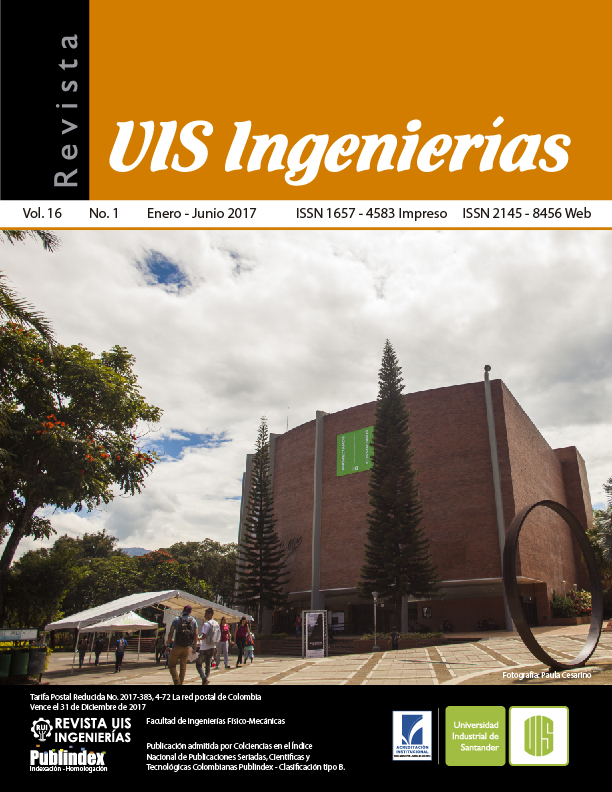Evaluation based on the gradient method of the elastic properties of human tissues in vivo
Published 2016-12-26
Keywords
- Finite element,
- gradient method,
- human tissues,
- material characterization
How to Cite
Abstract
At present, the numerical simulation of the mechanical behavior of human tissues in the field of medicine is a field of study that has aroused great interest in the scientific community. The study of the behavior of these tissues entails a great difficulty, partly attributed to the fact that the behavior of these tissues changes from patient to patient and in many occasions it is not possible to perform direct experiments on the tissue to determine its elastic properties. For this purpose, the present work proposes a method to find these properties assuming a constitutive model of Mooney-Rivlin. This method is based on the information provided by medical images in two situations of organ deformation and, through a process of optimization based on the gradient, the elastic properties of the constitutive model are obtained with precision. The numerical experiments performed demonstrate the validity of the method for the example used.
Downloads
References
- K. K. Brock, S. J. Hollister, L. A. Dawson, and J. M. Balter. “Technical note: creating a four-dimensional model
- of the liver using finite element analysis.” Medical physics,
- vol. 29, no. 7, pp. 1403–5, jul 2002. [Online]. Available:
- http://www.ncbi.nlm.nih.gov/pubmed/12148719
- B. D. de Senneville, M. Ries, G. Maclair, and C. Moonen, “MR-guided thermotherapy of abdominal organs using a robust PCA-based motion descriptor.” IEEE transactions on medical imaging, vol. 30, no. 11, pp. 1987–95, nov 2011. [Online]. Available: http://www.ncbi.nlm.nih.gov/pubmed/21724501
- A. Mena, D. Bel, I. Alfaro, D. González, E. Cueto, and F. Chinesta, “Towards a pancreatic surgery simulator based on model order reduction,” Advanced Modeling and Simulation in Engineering Sciences, vol. 2, no. 1, p. 31, dec 2015. [Online]. Available: http://www.amses-journal.com/content/2/1/31
- E. Cueto and F. Chinesta, “Real time simulation for computational
- surgery: a review,” Advanced Modeling and Simulation in Engineering Sciences, vol. 1, no. 1, p. 11, 2014. [Online]. Available: http://amses-journal.springeropen.com/articles/10.1186/2213-7467-1-11
- S. Niroomandi, D. González, I. Alfaro, F. Bordeu, A. Leygue, E. Cueto, and F. Chinesta, “Real-time simulation of biological soft tissues: a PGD approach.” International journal for numerical methods in biomedical engineering, vol. 29, no. 5, pp. 586–600, may 2013. [Online]. Available: http://www.ncbi.nlm.nih.gov/pubmed/23495247
- S. Niroomandi, I. Alfaro, D. González, E. Cueto, and F. Chinesta, “Model order reduction in hyperelasticity: a proper generalized decomposition approach,” International Journal for Numerical Methods in Engineering, pp. n/a–n/a, jul 2013. [Online]. Available: http://doi.wiley.com/10.1002/nme.4531
- F. M. Martínez, “Determining the Biomechanical Behaviour of the Liver using Medical Image Analysis and Evolutionary Computation,” Ph.D. dissertation, Universitat Politècnica de València, 2014
- J. Snyman, Practical Mathematical Optimization, ser. Applied Optimization. New York: Springer-Verlag, 2005, vol. 97. [Online]. Available: http://link.springer.com/10.1007/b105200
- S. Niroomandi, D. Gonzalez, I. Alfaro, F. Bordeu, A. Leygue, E. Cueto, and F. Chinesta, “Real-time simulation of biological soft tissues: a PGD approach,” International Journal for Numerical Methods in Biomedical Engineering, vol. 0, pp. 1–16, 2012. [Online]. Available: http://amb.unizar.es/PDFs/NiroomandiAlfaroCuetoChinesta2.pdf
- A. Myronenko and X. Song, “Point Set Registration: Coherent Point Drift,” IEEE Transactions on Pattern Analysis and Machine Intelligence, vol. 32, no. 12, pp. 2262–2275, 2010. [Online]. Available: http://ieeexplore.ieee.org/xpl/login.jsp?tp={&}arnumber=5432191{&}url=http{%}3A{%}2F{%}2Fieeexplore.ieee.org{%}2Fxpls{%}2Fabs{_}all.jsp{%}3Farnumber{%}3D5432191
- S. Hartmann, “Parameter estimation of hyperelasticity relations of generalized polynomial-type with constraint conditions,” International Journal of Solids and Structures, vol. 38, no. 44-45, pp. 7999–8018, 2001.

